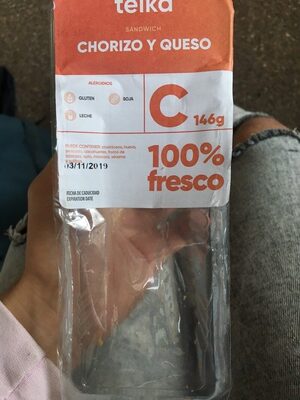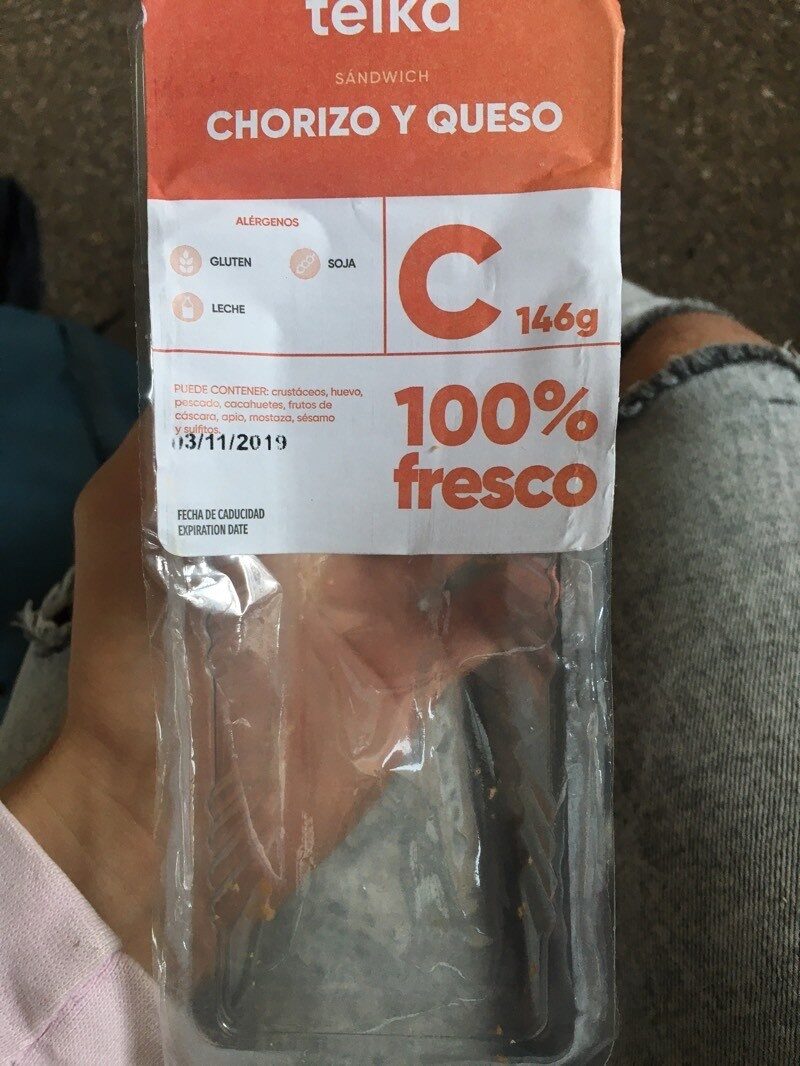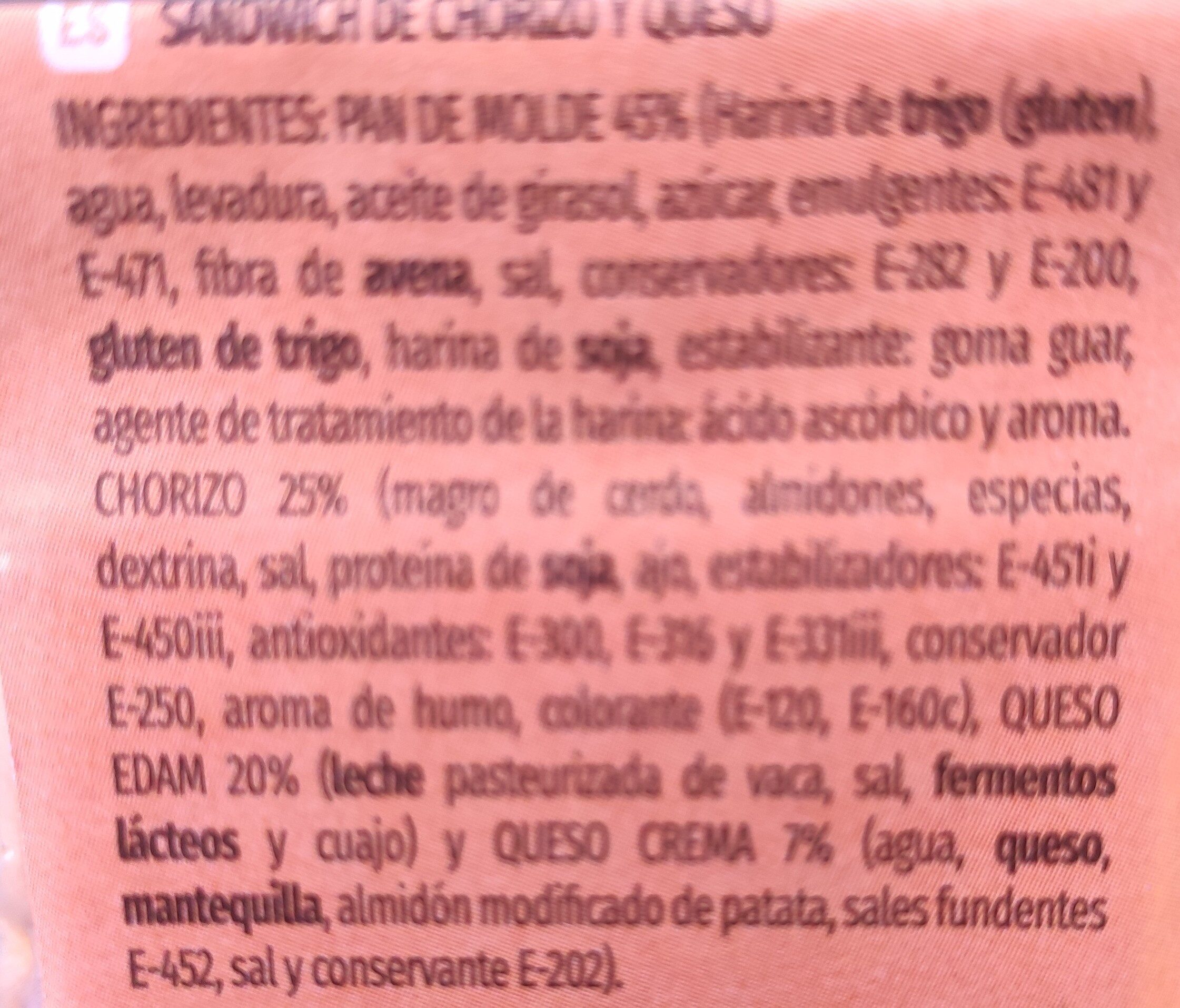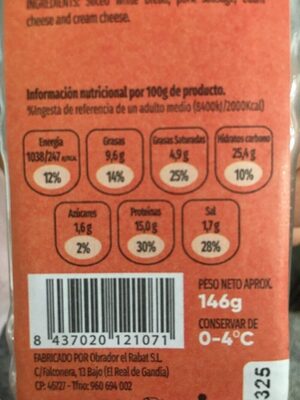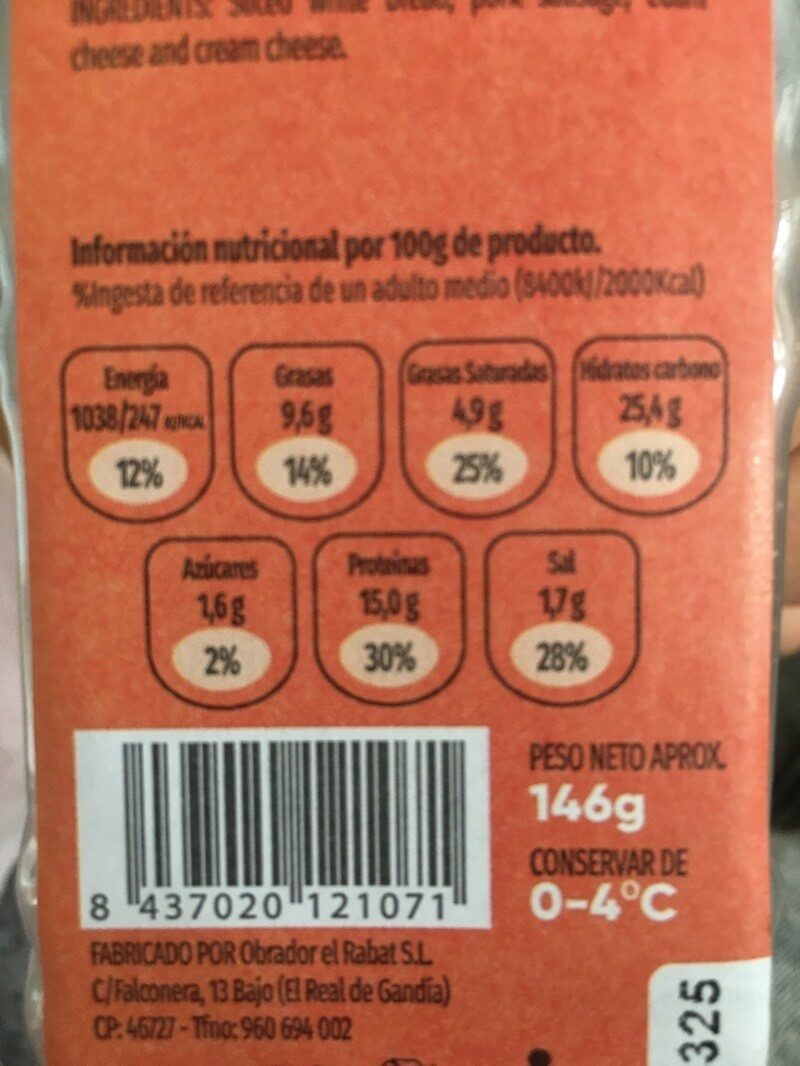Ajuda'ns a fer que la transparència alimentària sigui la norma!
Com a organització sense ànim de lucre, depenem de les vostres donacions per continuar informant els consumidors de tot el món sobre tot allò què mengen.
La revolució alimentària comença amb tu!
Sandwich chorizo y queso - Teika - 146g
Sandwich chorizo y queso - Teika - 146g
Aquesta pàgina del producte no està completa. Podeu ajudar a completar-la editant-la i afegint-hi més dades a partir de les fotos ja disponibles, o fent-ne més amb l'aplicació de androide o iPhone / iPad. Gràcies!
×
Codi de barres: 8437020121071 (EAN / EAN-13)
Quantitat: 146g
Marques: Teika
Categories: Sanvitxos
Països on es va vendre: Espanya
Matching with your preferences
Salut
Ingredients
-
55 ingredients
: PAN DE MOLDE 45% (Harina de trigo (gluten), agua, levadura, aceite de girasol, azúcar, emulgentes: E-481 y E-471, fibra de avena, sal, conservadores: E-282 y E-200, gluten de trigo, harina de soja, estabilizante: goma guar, agente de tratamiento de la harina: ácido ascórbico y aroma. CHORIZO 25% (magro de cerdo, almidones, especias, dextrina, sal, proteína de soja, ajo, estabilizadores: E-451i y E-450iii, antioxidantes: E-300, E-316 y E-331iii, conservador E-250, aroma de humo, colorante (E-120, E-160c), QUESO EDAM 20% (leche pasteurizada de vaca, sal, fermentos lácteos y cuajo) y QUESO CREMA 7% (agua, queso, mantequilla, almidón modificado de patata, sales fundentes E-452, sal y conservante E-202).Al·lèrgens: en:Gluten, en:Milk
Processament d'aliments
-
Aliments ultra processats
Elements que indiquen que el producte està al grup 4 - Aliments i begudes ultraprocessats:
- Additiu: E120 - Carmí
- Additiu: E1400 - Dextrina
- Additiu: E14XX - Midó modificat
- Additiu: E160c - Capsantina
- Additiu: E412 - Goma de guar
- Additiu: E450 - Difosfat
- Additiu: E451 - Trifosfat
- Additiu: E452 - Polifosfat
- Additiu: E471 - Monoglicèrids i diglicèrids d'àcids grassos
- Additiu: E481 - Estearoïl-2-lactilat de sodi
- Ingredient: Color
- Ingredient: Emulsionant
- Ingredient: Aromes
- Ingredient: Gluten
Els productes alimentaris es classifiquen en 4 grups segons el seu grau de processament:
- Aliments no processats o mínimament processats
- Ingredients culinaris processats
- Aliments processats
- Aliments ultra processats
La determinació del grup es fa en funció de la categoria del producte i dels ingredients que conté.
Additius
-
E120 - Carmí
Carminic acid: Carminic acid -C22H20O13- is a red glucosidal hydroxyanthrapurin that occurs naturally in some scale insects, such as the cochineal, Armenian cochineal, and Polish cochineal. The insects produce the acid as a deterrent to predators. An aluminum salt of carminic acid is the coloring agent in carmine. Synonyms are C.I. 75470 and C.I. Natural Red 4. The chemical structure of carminic acid consists of a core anthraquinone structure linked to a glucose sugar unit. Carminic acid was first synthesized in the laboratory by organic chemists in 1991.Origen: Wikipedia (Anglès)
-
E1400 - Dextrina
Dextrin: Dextrins are a group of low-molecular-weight carbohydrates produced by the hydrolysis of starch or glycogen. Dextrins are mixtures of polymers of D-glucose units linked by α--1→4- or α--1→6- glycosidic bonds. Dextrins can be produced from starch using enzymes like amylases, as during digestion in the human body and during malting and mashing, or by applying dry heat under acidic conditions -pyrolysis or roasting-. The latter process is used industrially, and also occurs on the surface of bread during the baking process, contributing to flavor, color and crispness. Dextrins produced by heat are also known as pyrodextrins. The starch hydrolyses during roasting under acidic conditions, and short-chained starch parts partially rebranch with α--1‚6- bonds to the degraded starch molecule. See also Maillard Reaction. Dextrins are white, yellow, or brown powders that are partially or fully water-soluble, yielding optically active solutions of low viscosity. Most of them can be detected with iodine solution, giving a red coloration; one distinguishes erythrodextrin -dextrin that colours red- and achrodextrin -giving no colour-. White and yellow dextrins from starch roasted with little or no acid are called British gum.Origen: Wikipedia (Anglès)
-
E200 - Àcid sòrbic
Sorbic acid: Sorbic acid, or 2‚4-hexadienoic acid, is a natural organic compound used as a food preservative. It has the chemical formula CH3-CH-4CO2H. It is a colourless solid that is slightly soluble in water and sublimes readily. It was first isolated from the unripe berries of the Sorbus aucuparia -rowan tree-, hence its name.Origen: Wikipedia (Anglès)
-
E250 - Nitrit de sodi
Sodium nitrite: Sodium nitrite is the inorganic compound with the chemical formula NaNO2. It is a white to slightly yellowish crystalline powder that is very soluble in water and is hygroscopic. It is a useful precursor to a variety of organic compounds, such as pharmaceuticals, dyes, and pesticides, but it is probably best known as a food additive to prevent botulism. It is on the World Health Organization's List of Essential Medicines, the most important medications needed in a basic health system.Nitrate or nitrite -ingested- under conditions that result in endogenous nitrosation has been classified as "probably carcinogenic to humans" by International Agency for Research on Cancer -IARC-.Origen: Wikipedia (Anglès)
-
E282 - Propanoat de calci
Calcium propanoate: Calcium propanoate or calcium propionate has the formula Ca-C2H5COO-2. It is the calcium salt of propanoic acid.Origen: Wikipedia (Anglès)
-
E316 - Eritorbat de sodi
Sodium erythorbate: Sodium erythorbate -C6H7NaO6- is a food additive used predominantly in meats, poultry, and soft drinks. Chemically, it is the sodium salt of erythorbic acid. When used in processed meat such as hot dogs and beef sticks, it increases the rate at which nitrite reduces to nitric oxide, thus facilitating a faster cure and retaining the pink coloring. As an antioxidant structurally related to vitamin C, it helps improve flavor stability and prevents the formation of carcinogenic nitrosamines. When used as a food additive, its E number is E316. The use of erythorbic acid and sodium erythorbate as a food preservative has increased greatly since the U.S. Food and Drug Administration banned the use of sulfites as preservatives in foods intended to be eaten fresh -such as ingredients for fresh salads- and as food processors have responded to the fact that some people are allergic to sulfites. It can also be found in bologna, and is occasionally used in beverages, baked goods, and potato salad.Sodium erythorbate is produced from sugars derived from different sources, such as beets, sugar cane, and corn. An urban myth claims that sodium erythorbate is made from ground earthworms; however, there is no truth to the myth. It is thought that the genesis of the legend comes from the similarity of the chemical name to the words earthworm and bait.Alternative applications include the development of additives that could be utilized as anti-oxidants in general. For instance, this substance has been implemented in the development of corrosion inhibitors for metals and it has been implemented in active packaging.Sodium erythorbate is soluble in water. The pH of the aqueous solution of the sodium salt is between 5 and 6. A 10% solution, made from commercial grade sodium erythorbate, may have a pH of 7.2 to 7.9. In its dry, crystalline state it is nonreactive. But, when in solution with water it readily reacts with atmospheric oxygen and other oxidizing agents, which makes it a valuable antioxidant.Origen: Wikipedia (Anglès)
-
E331 - Citrats de sodi
Sodium citrate: Sodium citrate may refer to any of the sodium salts of citrate -though most commonly the third-: Monosodium citrate Disodium citrate Trisodium citrateThe three forms of the salt are collectively known by the E number E331. Sodium citrates are used as acidity regulators in food and drinks, and also as emulsifiers for oils. They enable cheeses to melt without becoming greasy.Origen: Wikipedia (Anglès)
-
E331iii - Citrat trisòdic
Sodium citrate: Sodium citrate may refer to any of the sodium salts of citrate -though most commonly the third-: Monosodium citrate Disodium citrate Trisodium citrateThe three forms of the salt are collectively known by the E number E331. Sodium citrates are used as acidity regulators in food and drinks, and also as emulsifiers for oils. They enable cheeses to melt without becoming greasy.Origen: Wikipedia (Anglès)
-
E412 - Goma de guar
Guar gum: Guar gum, also called guaran, is a galactomannan polysaccharide extracted from guar beans that has thickening and stabilizing properties useful in the food, feed and industrial applications. The guar seeds are mechanically dehusked, hydrated, milled and screened according to application. It is typically produced as a free-flowing, off-white powder.Origen: Wikipedia (Anglès)
-
E451 - Trifosfat
Sodium triphosphate: Sodium triphosphate -STP-, also sodium tripolyphosphate -STPP-, or tripolyphosphate -TPP-,- is an inorganic compound with formula Na5P3O10. It is the sodium salt of the polyphosphate penta-anion, which is the conjugate base of triphosphoric acid. It is produced on a large scale as a component of many domestic and industrial products, especially detergents. Environmental problems associated with eutrophication are attributed to its widespread use.Origen: Wikipedia (Anglès)
-
E451i
Sodium triphosphate: Sodium triphosphate -STP-, also sodium tripolyphosphate -STPP-, or tripolyphosphate -TPP-,- is an inorganic compound with formula Na5P3O10. It is the sodium salt of the polyphosphate penta-anion, which is the conjugate base of triphosphoric acid. It is produced on a large scale as a component of many domestic and industrial products, especially detergents. Environmental problems associated with eutrophication are attributed to its widespread use.Origen: Wikipedia (Anglès)
-
E471 - Monoglicèrids i diglicèrids d'àcids grassos
Mono- and diglycerides of fatty acids: Mono- and diglycerides of fatty acids -E471- refers to a food additive composed of diglycerides and monoglycerides which is used as an emulsifier. This mixture is also sometimes referred to as partial glycerides.Origen: Wikipedia (Anglès)
-
E481 - Estearoïl-2-lactilat de sodi
Sodium stearoyl lactylate: Sodium stearoyl-2-lactylate -sodium stearoyl lactylate or SSL- is a versatile, FDA approved food additive used to improve the mix tolerance and volume of processed foods. It is one type of a commercially available lactylate. SSL is non-toxic, biodegradable, and typically manufactured using biorenewable feedstocks. Because SSL is a safe and highly effective food additive, it is used in a wide variety of products ranging from baked goods and desserts to pet foods.As described by the Food Chemicals Codex 7th edition, SSL is a cream-colored powder or brittle solid. SSL is currently manufactured by the esterification of stearic acid with lactic acid and partially neutralized with either food-grade soda ash -sodium carbonate- or caustic soda -concentrated sodium hydroxide-. Commercial grade SSL is a mixture of sodium salts of stearoyl lactylic acids and minor proportions of other sodium salts of related acids. The HLB for SSL is 10-12. SSL is slightly hygroscopic, soluble in ethanol and in hot oil or fat, and dispersible in warm water. These properties are the reason that SSL is an excellent emulsifier for fat-in-water emulsions and can also function as a humectant.Origen: Wikipedia (Anglès)
Anàlisi dels ingredients
-
Pot contenir oli de palma
Ingredients que poden contenir oli de palma: E481, E471
-
No és vegà
Ingredients no vegans: Xoriço, Magre de porc, E120, Formatge edam, Llet de vaca pasteuritzada, Formatge, MantegaAlguns ingredients no s'han pogut reconèixer.
Necessitem la teva ajuda!
Podeu ajudar-nos a reconèixer més ingredients i analitzar millor la llista d'ingredients d'aquest producte i d'altres mitjançant:
- Editeu aquesta pàgina de producte per corregir les faltes d’ortografia de la llista d’ingredients i/o per eliminar els ingredients d’altres idiomes i frases que no estiguin relacionades amb els ingredients.
- Afegiu entrades, sinònims o traduccions noves a les nostres llistes multilingües d’ingredients, mètodes de processament d’ingredients i etiquetes.
Uniu-vos al canal #ingredients del nostre espai de discussió a Slack i/o apreneu sobre l'anàlisi dels ingredients en la nostra wiki, si voleu ajudar. Gràcies!
-
No és vegetarià
Ingredients no vegetarians: Xoriço, Magre de porc, E120Alguns ingredients no s'han pogut reconèixer.
Necessitem la teva ajuda!
Podeu ajudar-nos a reconèixer més ingredients i analitzar millor la llista d'ingredients d'aquest producte i d'altres mitjançant:
- Editeu aquesta pàgina de producte per corregir les faltes d’ortografia de la llista d’ingredients i/o per eliminar els ingredients d’altres idiomes i frases que no estiguin relacionades amb els ingredients.
- Afegiu entrades, sinònims o traduccions noves a les nostres llistes multilingües d’ingredients, mètodes de processament d’ingredients i etiquetes.
Uniu-vos al canal #ingredients del nostre espai de discussió a Slack i/o apreneu sobre l'anàlisi dels ingredients en la nostra wiki, si voleu ajudar. Gràcies!
-
Detalls de l'anàlisi dels ingredients
Necessitem la teva ajuda!
Alguns ingredients no s'han pogut reconèixer.
Necessitem la teva ajuda!
Podeu ajudar-nos a reconèixer més ingredients i analitzar millor la llista d'ingredients d'aquest producte i d'altres mitjançant:
- Editeu aquesta pàgina de producte per corregir les faltes d’ortografia de la llista d’ingredients i/o per eliminar els ingredients d’altres idiomes i frases que no estiguin relacionades amb els ingredients.
- Afegiu entrades, sinònims o traduccions noves a les nostres llistes multilingües d’ingredients, mètodes de processament d’ingredients i etiquetes.
Uniu-vos al canal #ingredients del nostre espai de discussió a Slack i/o apreneu sobre l'anàlisi dels ingredients en la nostra wiki, si voleu ajudar. Gràcies!
: PAN DE MOLDE 45%, Harina de trigo, agua, levadura, aceite de girasol, azúcar, emulgentes (e481), e471, fibra de avena, sal, conservadores (e282), e200, gluten de trigo, harina de soja, estabilizante (goma guar), agente de tratamiento de la harina (ácido ascórbico, aroma, CHORIZO 25%, magro de cerdo), almidones, especias, dextrina, sal, proteína de soja, ajo, estabilizadores (e451i), e450iii, antioxidantes (e300), e316, e331iii, conservador (e250), aroma de humo, colorante (e120, e160c), QUESO EDAM 20% (leche pasteurizada de vaca, sal, fermentos lácteos, cuajo), QUESO CREMA 7% (agua, queso, mantequilla, almidón modificado de patata, sales fundentes (e452), sal y conservante e202)- PAN DE MOLDE -> es:pan-de-molde - percent: 45
- Harina de trigo -> en:wheat-flour - vegan: yes - vegetarian: yes - ciqual_proxy_food_code: 9410
- agua -> en:water - vegan: yes - vegetarian: yes - ciqual_food_code: 18066
- levadura -> en:yeast - vegan: yes - vegetarian: yes
- aceite de girasol -> en:sunflower-oil - vegan: yes - vegetarian: yes - from_palm_oil: no - ciqual_food_code: 17440
- azúcar -> en:sugar - vegan: yes - vegetarian: yes - ciqual_proxy_food_code: 31016
- emulgentes -> en:emulsifier
- e481 -> en:e481 - vegan: maybe - vegetarian: maybe - from_palm_oil: maybe
- e471 -> en:e471 - vegan: maybe - vegetarian: maybe - from_palm_oil: maybe
- fibra de avena -> en:oat-fibre - vegan: yes - vegetarian: yes - ciqual_food_code: 9310
- sal -> en:salt - vegan: yes - vegetarian: yes - ciqual_food_code: 11058
- conservadores -> en:preservative
- e282 -> en:e282 - vegan: yes - vegetarian: yes
- e200 -> en:e200 - vegan: yes - vegetarian: yes
- gluten de trigo -> en:wheat-gluten - vegan: yes - vegetarian: yes
- harina de soja -> en:soya-flour - vegan: yes - vegetarian: yes - ciqual_food_code: 20900
- estabilizante -> en:stabiliser
- goma guar -> en:e412 - vegan: yes - vegetarian: yes
- agente de tratamiento de la harina -> en:flour-treatment-agent
- ácido ascórbico -> en:e300 - vegan: yes - vegetarian: yes
- aroma -> en:flavouring - vegan: maybe - vegetarian: maybe
- CHORIZO -> en:chorizo - vegan: no - vegetarian: no - ciqual_food_code: 30315 - percent: 25
- magro de cerdo -> en:lean-pork - vegan: no - vegetarian: no - ciqual_proxy_food_code: 28205
- almidones -> es:almidones
- especias -> en:spice - vegan: yes - vegetarian: yes
- dextrina -> en:e1400 - vegan: yes - vegetarian: yes
- sal -> en:salt - vegan: yes - vegetarian: yes - ciqual_food_code: 11058
- proteína de soja -> en:soy-protein - vegan: yes - vegetarian: yes - ciqual_food_code: 20591
- ajo -> en:garlic - vegan: yes - vegetarian: yes - ciqual_food_code: 11000
- estabilizadores -> en:stabiliser
- e451i -> en:e451i - vegan: yes - vegetarian: yes
- e450iii -> en:e450iii - vegan: yes - vegetarian: yes
- antioxidantes -> en:antioxidant
- e300 -> en:e300 - vegan: yes - vegetarian: yes
- e316 -> en:e316 - vegan: yes - vegetarian: yes
- e331iii -> en:e331iii - vegan: yes - vegetarian: yes
- conservador -> en:preservative
- e250 -> en:e250 - vegan: yes - vegetarian: yes
- aroma de humo -> en:smoke-flavouring - vegan: maybe - vegetarian: maybe
- colorante -> en:colour
- e120 -> en:e120 - vegan: no - vegetarian: no
- e160c -> en:e160c - vegan: yes - vegetarian: yes
- QUESO EDAM -> en:edam - vegan: no - vegetarian: maybe - ciqual_food_code: 12729 - percent: 20
- leche pasteurizada de vaca -> en:pasteurised-cow-s-milk - vegan: no - vegetarian: yes - ciqual_proxy_food_code: 19051
- sal -> en:salt - vegan: yes - vegetarian: yes - ciqual_food_code: 11058
- fermentos lácteos -> en:lactic-ferments - vegan: maybe - vegetarian: yes
- cuajo -> en:rennet - vegan: maybe - vegetarian: maybe
- QUESO CREMA -> es:queso-crema - percent: 7
- agua -> en:water - vegan: yes - vegetarian: yes - ciqual_food_code: 18066
- queso -> en:cheese - vegan: no - vegetarian: maybe - ciqual_proxy_food_code: 12999
- mantequilla -> en:butter - vegan: no - vegetarian: yes - ciqual_proxy_food_code: 16400
- almidón modificado de patata -> en:modified-potato-starch - vegan: yes - vegetarian: yes - ciqual_proxy_food_code: 9510
- sales fundentes -> en:emulsifying-salts
- e452 -> en:e452 - vegan: yes - vegetarian: yes
- sal y conservante e202 -> es:sal-y-conservante-e202
Nutrició
-
Poca qualitat nutricional
⚠ ️Atenció: la quantitat de fibra no s'especifica, no es tindrà en compte la seva possible contribució positiva en la qualificació.⚠ ️Atenció: la quantitat de fruita, verdura i fruits secs no s'especifica a l'etiqueta, s'ha fet una estimació a partir de la llista d'ingredients: 0Aquest producte no es considera una beguda per al càlcul de la Nutri-Score.
Punts positius: 0
- Proteïnes: 5 / 5 (valor: 15, valor arrodonit: 15)
- Fibra: 0 / 5 (valor: 0, valor arrodonit: 0)
- Fruites, verdures, fruits secs i olis de colza/nou/oliva: 0 / 5 (valor: 2.62260437011719e-05, valor arrodonit: 0)
Punts negatius: 14
- Energia: 3 / 10 (valor: 1038, valor arrodonit: 1038)
- Sucres: 0 / 10 (valor: 1.6, valor arrodonit: 1.6)
- Greixos saturats: 4 / 10 (valor: 4.9, valor arrodonit: 4.9)
- Sodi: 7 / 10 (valor: 680, valor arrodonit: 680)
Els punts per proteïnes no es compten perquè els punts negatius són més o iguals a 11.
Puntuació nutricional: (14 - 0)
Nutri-Score:
-
Nivells de nutrients
-
Greix en Quantitat moderada (9.6%)
Què us cal saber- Un alt consum de greixos, especialment de greixos saturats, pot augmentar el colesterol, que augmenta el risc de patir malalties del cor.
Recomanació: Reduïu el consum de greixos i greixos saturats- Trieu productes amb menys greixos i greixos saturats.
-
Àcid gras saturat en Quantitat moderada (4.9%)
Què us cal saber- Un alt consum de greixos, especialment de greixos saturats, pot augmentar el colesterol, que augmenta el risc de patir malalties del cor.
Recomanació: Reduïu el consum de greixos i greixos saturats- Trieu productes amb menys greixos i greixos saturats.
-
Sucre en baixa quantitat (1.6%)
Què us cal saber- Un alt consum de sucre pot provocar augment de pes i càries dental. També augmenta el risc de patir diabetis tipus 2 i malalties cardiovasculars.
Recomanació: Limitau el consum de sucre i de begudes ensucrades- Les begudes ensucrades (com ara refrescos, begudes de fruites i sucs i nèctars de fruites) s'han de limitar tant com sigui possible (no més d'1 got al dia).
- Triau productes amb menor contingut de sucre i reduïu el consum de productes amb sucres afegits.
-
Sal comuna en alta quantitat (1.7%)
Què us cal saber- Un alt consum de sal (o sodi) pot provocar un augment de la pressió arterial, que pot augmentar el risc de patir malalties del cor i ictus.
- Moltes persones que tenen hipertensió no ho saben, ja que sovint no en tenen símptomes.
- La majoria de la gent consumeix massa sal (de 9 a 12 grams de mitjana al dia), al voltant del doble del nivell màxim d'ingesta recomanat.
Recomanació: Limitau la ingesta de sal i d'aliments rics en sal- Reduïu la sal que emprau quan cuinau, i no afegiu sal a taula.
- Limiteu el consum d'aperitius salats i trieu productes amb menor contingut de sal.
-
-
Informació nutricional
Informació nutricional Com es ven
per 100 g/100 mlComparat amb: Sanvitxos Energia 1.038 kj
(247 kcal)+16% Greix 9,6 g -7% Àcid gras saturat 4,9 g +60% Hidrats de carboni 25,4 g +53% Sucre 1,6 g -37% Fiber ? Proteïna 15 g +26% Sal comuna 1,7 g +6% Fruits‚ vegetables‚ nuts and rapeseed‚ walnut and olive oils (estimate from ingredients list analysis) 0 %
Entorn
-
Puntuació ecològica no calculada - Impacte ambiental desconegut
No hem pogut calcular l'Eco-Score d'aquest producte perquè li falten algunes dades, podríeu ajudar-nos a completar-lo?Podries afegir una categoria del producte més precisa perquè puguem calcular l'Eco-Score? Afegir una categoria
Empaquetament
-
Falta informació sobre l'embalatge d'aquest producte
⚠ ️ La informació sobre l'embalatge d'aquest producte no està completada.Take a photo of the recycling information Take a photo of the recycling information
Transport
-
Orígens dels ingredients
Falta informació sobre l'origen dels ingredients
⚠ ️ L'origen dels ingredients d'aquest producte no està indicat.
Si estan indicats a l'embalatge, podeu modificar la fitxa del producte i afegir-los.
Si sou el fabricant d'aquest producte, podeu enviar-nos la informació amb la nostra plataforma gratuïta per a productors.Add the origins of ingredients for this product Add the origins of ingredients for this product
Report a problem
-
Incomplete or incorrect information?
Category, labels, ingredients, allergens, nutritional information, photos etc.
If the information does not match the information on the packaging, please complete or correct it. Open Food Facts is a collaborative database, and every contribution is useful for all.
Fonts de dades
Producte afegit per elcoco
Última modificació de la pàgina del producte per shirokureiji.
La pàgina del producte, també editada per elcoco.5643fcfe7ce3c570ddae8092f2e108d9, foodvisor, musarana, roboto-app.
